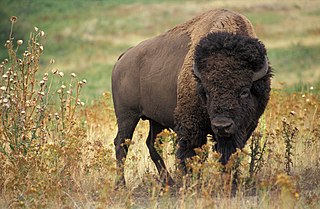Encyclopedia Dubuque
"Encyclopedia Dubuque is the online authority for all things Dubuque, written by the people who know the city best.”
Marshall Cohen—researcher and producer, CNN
Affiliated with the Local History Network of the State Historical Society of Iowa, and the Iowa Museum Association.
BISON
BISON. The American bison, inappropriately called "buffalo," was named the national mammal of the United States on May 9, 2016. This animal joins EAGLE (BALD) as official symbols of our country—and much like the eagle, they’re one of the greatest conservation success stories of all time. Historians believe the term “buffalo” grew from the French word for beef, “boeuf.” (1)
In prehistoric times, millions of bison roamed North America—from the forests of Alaska and the grasslands of Mexico to Nevada’s Great Basin and the eastern Appalachian Mountains. In the summer of 1812 buffalo were so numerous in the vicinity of Dubuque that a party of dragoons remained in camp on the hills, five miles distant, several days until the herd moved southward. It was then considered safe to approach the French-Indian village at CATFISH CREEK. (2)
The history of bison has been linked with many communities of Native Americans. By the late 1800s, there were only a few hundred bison left in the United States after European settlers pushed west, reducing the animal’s habitat and hunting the bison to near extinction. Without a few private individuals working with tribes of Native Americans, states and the Department of the Interior, the bison would have become extinct. Theodore Roosevelt helped save bison from extinction. In 1883, Roosevelt traveled to the Dakota Territory to hunt bison. After spending a few years in the west, Roosevelt returned to New York with a new outlook on life. He paved the way for the conservation movement, and in 1905, formed the American Bison Society with William Hornaday to save the disappearing bison. Today bison live in all 50 states, including tribal lands, wildlife refuges, national parks and private lands.
Bison are the largest mammal in North America. Male bison (called bulls) weigh up to 2,000 pounds and stand 6 feet tall, while females (called cows) weigh up to 1,000 pounds and reach a height of 4-5 feet. Bison calves weigh 30-70 pounds at birth. Bison calves tend to be born from late March through May and are orange-red in color, earning them the nickname “red dogs.” After a few months, their hair starts to change to dark brown and their characteristic shoulder hump and horns begin to grow. Since the late 19th century, the interior has been the primary realm of the bison. Public lands managed by Department of Interior support 17 bison herds—or approximately 10,000 bison—in 12 states, including Alaska. This is equal to an estimated one-third of all wild bison in North America.
Yellowstone National Park is the only place in the U.S. where bison have continuously lived since prehistoric times. The American bison’s ancestors can be traced to southern Asia thousands of years ago. Bison made their way to America by crossing the ancient land bridge that once connected Asia with North America during the Pliocene Epoch, some 400,000 years ago. These ancient animals were much larger than the bison we love today. Fossil records show that one prehistoric bison, Bison latiforns, had horns measuring 9 feet from tip to tip. Yellowstone’s bison are the descendants of early bison that roamed our country’s grasslands. In 2021, Yellowstone’s bison population was estimated at 5,450—making it the largest bison population on public lands. This population is allowed to roam relatively freely over the expansive landscape of Yellowstone National Park and some nearby areas of Montana.
A bison’s mood can be determined by its tail. When it hangs down and switches naturally, the bison is usually calm. If the tail is standing straight up it may be ready to charge. No matter what a bison’s tail is doing, they are unpredictable and can charge at any moment. Bison may be big, but they’re also fast. They can run up to 35 miles per hour. Plus, they’re extremely agile. Bison can spin around quickly, jump high fences and are strong swimmers.
Wind Cave National Park’s herd in South Dakota helped revive bison populations around the country. The story began in 1905 with the formation of the American Bison Society and a breeding program at the New York City Zoo (today, the Bronx Zoo). By 1913, the American Bison Society had enough bison to restore a free-ranging bison herd. Working with Interior, they donated 14 bison to Wind Cave National Park in South Dakota. More than 100 years later, the bison from Wind Cave have helped reestablishing other herds across the United States and most recently in Mexico.
Bison primarily eat grasses, weeds and leafy plants—typically foraging for nine to 11 hours a day. That’s where the bison’s large protruding shoulder hump comes in handy during the winter. It allows them to swing their heads from side-to-side to clear snow—especially for creating foraging patches.
Bison can live up to 20 years old. The average lifespan for a bison is 10–20 years, but some live to be older. Cows begin breeding at the age of two and only have one baby at a time. For males, the prime breeding age is six to 10 years.
Bison are nearsighted. While bison have poor eyesight, they have excellent senses of smell and hearing. Cows and calves communicate using pig-like grunts, and during mating season, bulls can be heard bellowing across long distances. (3)
---
Source:
1. "15 Facts About Our National Mammal: The American Bison," U.S. Department of the Interior. Online: https://www.doi.gov/blog/15-facts-about-our-national-mammal-american-bison
3. "Caught on the Fly," Dubuque Herald, March 31, 1876, p. 4. Online: https://news.google.com/newspapers?nid=uh8FjILnQOkC&dat=18760331&printsec=frontpage&hl=en
3. "15 Facts..."


